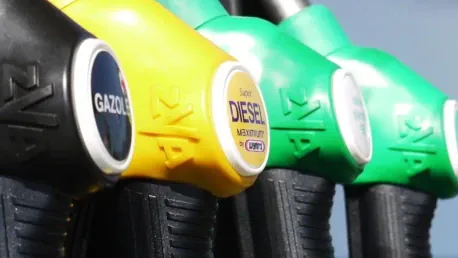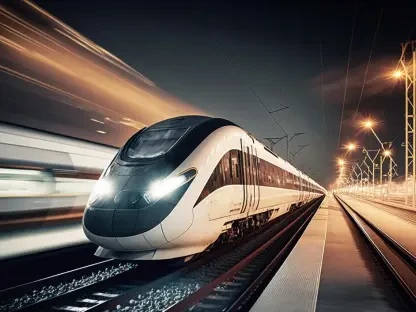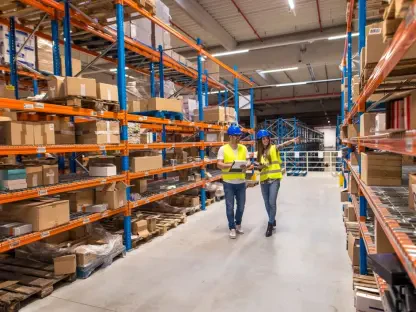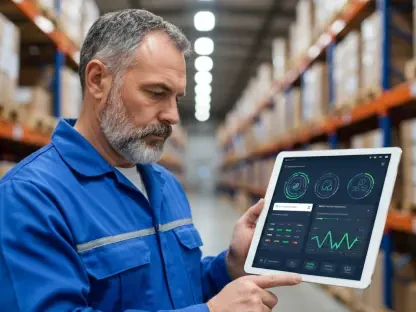In a world increasingly focused on sustainability, addressing the emissions from Light Commercial Vehicles (LCVs) in the logistics sector has become crucial. A recent report by McKinsey & Company identifies LCVs as significant contributors to air pollution, responsible for around 40 percent of the emissions in this industry. As such, finding viable solutions to reduce these emissions is more pressing than ever. An emerging solution gaining attention is retrofitting existing diesel vans with electric powertrains.
The Current State of LCV Emissions
The Dominance of Diesel
Despite ongoing discussions about sustainable alternatives, diesel-powered LCVs continue to dominate the logistics sector. Data from the Society of Motor Manufacturers and Traders (SMMT) reveals that diesel LCV registrations have surged, reaching 187,223 units so far this year, with more than 5,000 new registrations in July 2024 alone. This trend underscores the inertia of the industry in transitioning to cleaner options. The economic allure of diesel vehicles, due to their lower upfront costs and reliable performance, seems to outweigh the environmental considerations for many fleet operators.
The dominance of diesel is not merely a reflection of current market preferences but also points to deeper systemic issues in the vehicle procurement process within the logistics sector. Fleet managers often face limited options when considering electric alternatives, and the existing infrastructure may not be supportive enough to facilitate an overnight switch to electric LCVs. Furthermore, diesel engines are perceived to be more robust and capable of managing the high demands and long distances typical in logistics operations, which evidently skews the market heavily in favor of diesel.
Decline of Electric Light Commercial Vehicles
Contrary to the increasing diesel registrations, battery-electric LCV (eLCV) registrations are on a downward trend. Only 5.1 percent of all new LCV registrations in 2024 are battery electric, a drop from 5.6 percent in the previous year. This reflects the economic and practical challenges fleets face when considering the switch to electric LCVs, including high upfront costs and concerns over load space. The perceived limitations in range and longer charging times also contribute to the gradual decline in eLCV uptake.
The high initial investment required for eLCVs can be prohibitive, particularly for small to mid-sized logistics companies operating on tight margins. These companies often prioritize immediate financial sustainability over long-term environmental benefits, making the leap to eLCVs a less attractive option. Additionally, logistical concerns such as reduced payload capacity due to battery weight and volume make eLCVs less feasible for operations that require maximum load efficiency. These challenges highlight the need for practical, intermediary solutions that bridge the gap between the current reliance on diesel and the future widespread adoption of electric vehicles.
Why Retrofitting Could Be the Solution
Economic and Environmental Benefits
Retrofitting existing diesel vehicles can be a cost-effective and environmentally friendly alternative. BEDEO, a leader in electric mobility, champions this approach, emphasizing its potential to preserve load space and significantly reduce CO2 emissions. By converting older diesel vans to electric, fleet operators can cut emissions without the high costs associated with buying new electric vehicles. This process involves integrating electric powertrains into existing diesel chassis, thereby extending the useful life of the vehicle while drastically minimizing its environmental footprint.
The economic advantages of retrofitting are considerable. Retrofitting costs are significantly lower than the purchase price of new electric LCVs, making it a more viable option for many logistics companies. The total cost of ownership (TCO) is also reduced, as electric vehicles generally have lower operational and maintenance costs compared to their diesel counterparts. Furthermore, retrofitting allows companies to continue using their current fleet without extensive operational disruptions, promoting a seamless transition toward more sustainable practices.
BEDEO’s Retrofitting Technology
BEDEO’s Stellantis-approved Reborn Electric system presents a practical solution for the logistics industry. This system allows for the retrofitting of diesel vans, maintaining operational efficacy while slashing emissions. The technology provides an immediate and efficient pathway toward reducing the environmental impact of LCVs, aligning well with broader environmental goals. BEDEO’s in-wheel motor technology ensures that the retrofitted vehicles retain their load capacity, addressing one of the primary concerns that fleet operators have regarding electric vehicles.
The Stellantis-approved Reborn Electric system is highly adaptable, able to retrofit a wide range of diesel vans to meet various operational needs. This versatility is crucial for logistics companies that operate diverse fleets and require customized solutions. The in-wheel motors used in this system also enhance vehicle performance by providing better torque and stability, making retrofitted vans not only eco-friendly but also more efficient in terms of operation. These technological advancements highlight the potential of retrofitting as a key strategy in the logistics industry’s transition to low-emission fleets.
Policy and Incentives: The Role of Government
Need for Government Support
To accelerate the adoption of retrofitting, support from governments and policymakers is essential. BEDEO’s whitepaper, “Accelerating the Transition, Supporting our Businesses: Enabling Low-Emission Fleets with Retrofit Electrification,” suggests that incentives for retrofitting and stricter regulations to maintain safety and quality standards are crucial. These measures can drive the logistics industry toward more sustainable practices. Financial incentives, such as grants and tax breaks, can make the initial investment in retrofitting more appealing to fleet operators.
Government policies that mandate lower emission standards can encourage the shift towards retrofitting by raising the bar for acceptable emissions levels from LCVs. Regulatory frameworks that support retrofitting can also ensure that converted vehicles meet rigorous safety and performance standards, thereby alleviating any concerns fleet operators might have about the reliability and safety of retrofitted vehicles. By creating a supportive policy environment, governments can play a pivotal role in transforming the logistics sector’s approach to sustainability.
Regulatory Frameworks and Incentives
Introducing financial incentives for retrofitting could significantly sway fleet operators’ decisions. Additionally, tightening emissions regulations can encourage the adoption of retrofitting solutions. Such policies can help bridge the gap between the industry’s current state and its potential for a greener future, providing both economic and environmental dividends. For instance, subsidies can offset the initial outlay required for retrofitting, making it financially viable for more fleet operators.
Moreover, establishing clear guidelines and performance metrics for retrofitted vehicles can create a level playing field, ensuring that all retrofitted LCVs meet high environmental and operational standards. These regulatory frameworks can also include provisions for regular inspections and certifications, ensuring that the vehicles remain compliant over their operational lifespan. With robust policy support, the logistics industry can be steered towards adopting retrofitting as a primary strategy in reducing their carbon footprint.
Industry Perspectives and Practical Challenges
Voices from the Industry
According to Osman Boyner, BEDEO’s Founder and CEO, retrofitting represents a sustainable and economically viable path forward for large van fleets across the UK. Boyner points out that retrofitting could enable fleet operations to continue with minimal downtime and lower overall costs. He advocates for greater industry awareness regarding the benefits of retrofitting, suggesting that it offers a quick win for companies looking to reduce their environmental impact without significant financial strain.
Boyner’s insights tap into the broader industry sentiment that while new electric LCVs are desirable, they are not currently practical on a large scale due to cost and operational challenges. Retrofitting, on the other hand, provides an immediate pathway to sustainability. It allows companies to make incremental changes without overhauling their entire fleet or disrupting their logistical processes. This pragmatic approach aligns well with the operational realities of the logistics sector, where efficiency and cost-effectiveness are paramount.
Overcoming Challenges
Despite the potential benefits, there are inherent challenges to retrofitting, including the initial costs and hesitation among fleet operators to disrupt their operations. However, with proper incentives and regulatory support, these challenges can be mitigated, making retrofitting a more attractive option compared to purchasing new electric vans. Educating fleet operators about the long-term cost savings and environmental benefits of retrofitting can also help in overcoming these initial barriers to adoption.
Addressing technical challenges is crucial for the successful implementation of retrofitting solutions. This involves ensuring that retrofitted vehicles are reliable, safe, and efficient. Continued research and development in retrofitting technology can also enhance its feasibility and effectiveness. Collaborations between stakeholders, including vehicle manufacturers, technology providers, and fleet operators, can drive innovation and streamline the retrofitting process. By tackling these challenges head-on, the logistics industry can unlock the full potential of retrofitting as a sustainable alternative.
Achieving Net-Zero Goals in Logistics
The Push for Net-Zero Emissions
The logistics industry is at a critical juncture, where rapid and innovative solutions are necessary to meet net-zero commitments. Retrofitting offers a viable solution to drastically cut emissions and improve air quality, contributing significantly to these goals. The environmental benefits of retrofitting align with the broader push for sustainability within the logistics sector, which is under increasing pressure to reduce its carbon footprint and adhere to stricter emissions standards.
As the industry moves towards net-zero emissions, retrofitting older diesel vans can serve as an effective stopgap measure. This approach allows the logistics sector to make immediate strides in reducing emissions while longer-term solutions, such as the widespread adoption of electric LCVs, continue to develop. The combination of retrofitting and regulatory support can help the industry make significant progress towards its net-zero targets, aligning operational practices with environmental objectives.
Supporting a Circular Economy
In an era where sustainability is a major concern, tackling the emissions from Light Commercial Vehicles (LCVs) in the logistics sector has become imperative. According to a recent McKinsey & Company report, LCVs are major contributors to air pollution, accounting for approximately 40 percent of the emissions within this industry. Therefore, identifying effective strategies to lessen these emissions is increasingly urgent. One emerging and promising solution is the retrofitting of existing diesel vans with electric powertrains. This approach not only leverages existing vehicle frameworks but also offers a more cost-effective pathway to reducing emissions compared to purchasing entirely new electric vehicles. Further, retrofitting can accelerate the transition toward greener logistics because it bypasses the lengthy production timelines required for new electric LCVs. As more companies and policymakers recognize the benefits of this method, it could become a cornerstone in the global effort to curtail air pollution and move toward a more sustainable future.









